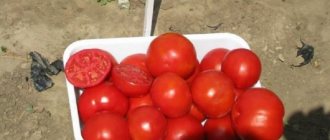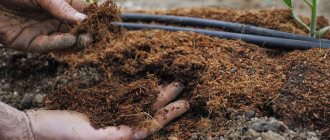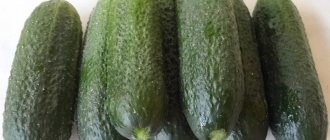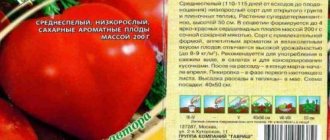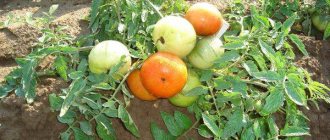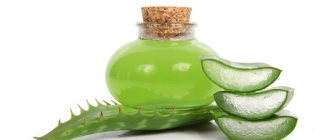Tomato Crown Prince F1 is a universal hybrid that grows and bears fruit well in different conditions. The variety is suitable for cultivation in open and protected beds; if agricultural practices are followed, it produces decent yields.
| Height | Landing location | Ripening time | Fruit color | Fruit size | Origin | Fruit shape |
| Tall | Greenhouse, Open ground | Mid-early | Reds | Large | Variety | With spout |
Description and characteristics of the Striped Chocolate tomato variety, their yield
The Striped Chocolate tomato was first bred by American breeders. Russian gardeners love tomatoes for their unusual appearance, large mass of fruits, good yield and excellent taste.
general characteristics
The variety belongs to the category of determinant. Its height reaches 1.5 meters. In greenhouse conditions, tomatoes grow up to 2 meters or more. The stem is powerful, persistent, the volume of foliage is moderate. The leaf blade is medium in size with pronounced wrinkles. The root system is powerful and branched. Plants are grown in 1-2 stems.
Considering the description of the variety, it is classified as mid-season. Technical maturity of the fruit occurs 95-105 days after the appearance of the first shoots. Productivity is good and friendly. Fruiting lasts until September.
The fruits belong to the maxi category. The diameter of tomatoes reaches 15 centimeters, and the weight of individual fruits is more than 1 kilogram. On average, the weight of tomatoes is in the range of 500-600 grams. The shape of the fruit is round, flattened. The peculiarity of the variety is chocolate stripes. At technical maturity, the color of tomatoes is burgundy or chocolate.
The color of stripes can vary from green to bright red. The skin is dense and shiny. Tomatoes have incredible taste and aroma.
The main use of the variety is fresh consumption. It is also suitable for preparing salads, canning, and growing for sale.
Features of agricultural technology
Like most nightshade crops, the Chocolate stripes variety is propagated using the seedling method. Sowing material is prepared by the last ten days of February - early March.
- Seeds are checked for germination. To do this, they are soaked in warm water for 10-15 minutes. Those seeds that float to the surface cannot be replanted.
- Special soil is prepared for seedlings. It consists of garden soil, sand and peat, taken in equal parts.
- The seeds are distributed into seedling containers with a density of 2-3 seeds per 1 centimeter. Sprinkle wet peat on top. The containers are covered with film or glass. Greenhouses are placed in a warm place until the first shoots appear.
- After the sprouts appear, the film is removed and the container is placed in a lighted place.
- Fertilizing is carried out on the 15th day after emergence of seedlings with nitrogenous fertilizers. They promote the growth of green mass.
- Seedlings are sensitive to excessive watering. It is produced as needed.
- Given the characteristics of the variety, tomatoes require picking. It is produced at the stage of 2-3 true leaves.
Striped chocolate tomato seedlings are transferred to a permanent place at the age of at least 55-60 days from the moment the first shoots appear. To obtain a high yield, a number of rules are followed.
- Hardening. A week before planting in the ground, the seedlings are hardened off with a decrease in day and night temperatures.
- Landing in the ground. The transfer of seedlings is carried out when the soil has warmed up to 15-16 degrees and night frosts have passed.
- Film protection. When transferred to open beds in the first days, the seedlings are covered with film.
- Choosing a location. Choose a place that is well lit, but without direct sunlight.
- Watering. Watering is carried out as needed in the evening. The next day after watering, loosen the soil.
- Mulching. The ground under the plants is sprinkled with mulch. It serves as a barrier for pests to penetrate seedlings.
- Stepsonning. Striped chocolate tomatoes belong to the tall category. They require stepsoning. The first removal of shoots is carried out 2 weeks after planting in the ground.
- Garter. Plants are tall. Therefore, they need a garter. It is also possible to install trellises.
- Feeding. Fertilization is carried out several times per season. Use complex or nitrogenous fertilizers.
Given the characteristics of tomatoes, in open ground conditions the crop begins to ripen in mid-July. In closed greenhouses, fruiting occurs earlier. It continues until the first days of September.
Variety resistance to diseases and pests
Characteristics of the Striped Chocolate tomato speak of it as a hybrid that is resistant to pests and the most common diseases.
According to reviews from gardeners, tomatoes are not susceptible to:
- powdery mildew;
- rot;
- late blight;
- mosaic.
Despite the high resistance to diseases, experts recommend preventive treatment of plants with complex antiparasitic drugs 1-2 times per season.
Compliance with the rules of agricultural technology allows you to achieve a high yield from the Striped Chocolate tomato variety.
Description of the Kron Prince tomato and recommendations for growing on the site
The Kron Prince tomato is intended for cultivation in greenhouse complexes and in open ground. This variety is sown in greenhouses in April, and plants are planted in open areas and temporary greenhouses in the second half of May. Tomatoes of this type are used fresh, canned and pickled.
Characteristics of the variety
The characteristics and description of the Kron Prince variety are as follows:
- The vegetative period of this variety, from planting seedlings to harvest, is 115-120 days.
- The bush of the plant can be from 120 to 200 cm in height. To obtain maximum yield, you need to remove the stepsons and tie all the stems to supports or trellises.
- When the bush is correctly formed into 1 or 2 stems and all agrotechnical measures are completed, the first inflorescence appears above the 8th leaf.
- From 15 to 25 fruits develop on the hand.
- The weight of tomatoes reaches 65-70 g. They have the shape of an oblong cylinder of red color.
- The described variety is resistant to diseases such as late blight.
Reviews from farmers growing tomatoes of this variety show that if all agricultural technology requirements are met, you can get a yield of 17-20 kg from every 1 m² of bed area. The described variety tolerates long-term transportation well.
The tomato is resistant to mechanical damage, its fruits do not crack. Therefore, Kron Prince tomatoes are purchased by trade organizations and companies specializing in the sale and processing of tomatoes.
This variety can be grown in open ground in the southern regions of Russia. In the vast expanses of Siberia and the Far North, it is recommended to plant plants in heated greenhouses. In central Russia, the described variety of tomato grows well under film coverings without heating.
Growing tomatoes in the garden
Seeds are planted to a depth of 10-15 mm in special soil located in boxes. This is best done in the last ten days of March. The soil is fertilized with humus or manure. After the appearance of seedlings with 1-2 leaves, the sprouts dive. Feeding of young plants is carried out 2-3 times during the entire period of growing seedlings. This is done with combined mixtures containing both nitrogen and phosphorus fertilizers.
Tomato Crown Prince - description and characteristics of the variety
The variety of tomatoes on the market allows you to choose the best varieties according to certain characteristics, taste or size, for canning or sale. The Crown Prince tomato is a high-yielding tomato with excellent taste and low calorie content, like many of the nightshade family.
Crown Prince is not a hybrid tomato, which allows you to collect seed material yourself from fully ripened fruits of the best quality. Growing the variety is possible not only in greenhouses and greenhouses, in open space, but also on an apartment loggia or kitchen window with further fruiting. You will need little soil for the root system - up to 6-7 kilograms. A flower pot or bucket with a capacity of up to 10 liters is suitable for these purposes.
The plant is tall with an average number of sharp leaves and requires obligatory gartering and removal of shoots. When grown in film greenhouses, it reaches a height of 2 meters, when in open space growth stops at around 1.5 - 1.6 meters. One bush at a time should be tied to vertical posts, connected by a horizontal crossbar. When forming a bush, the garter should be controlled or moved as the inflorescences form and the stem lengthens.
The timing of sowing and picking depending on the location of planting
To plant ready-made seedlings on open ground, it is advisable to sow at the end of the month of March, when the earth is already warmed up by the spring sun's rays and rooting of plants in April will be more comfortable. Plants are planted at the age of 40 - 50 days, with 4 - 5 leaves formed. If weather conditions are unstable by this planting period, then it is possible to cover the planted sprouts with temporary film greenhouses.
To grow tomatoes directly at the fruiting site, without picking and replanting, sowing should be done at the end of April, in well-warmed soil, possibly covered with agronomic fiber to accelerate seed germination. This fiber allows heat and moisture to pass through, maintaining the required temperature and humidity for seedlings. When warm nights are reached, without freezing of the soil surface, the fiber must be removed, and the grown seedlings must be thinned to the required distances between adult plants. The removed seedlings can be planted in free space, selecting the strongest and most even stems with good roots.
It is possible to grow tomatoes indoors in small quantities, but in winter conditions the plants slow down their growth, despite additional feeding and lighting. Caring for bushes in winter is a pleasure, reminiscent of the summer harvest.
Caring for the bush during the growing season does not require additional knowledge and skills. The soil is subjected to periodic loosening for better access of oxygen to the roots of the plants; weeds are completely removed and taken outside the area where the tomatoes are grown. It is important to periodically fertilize with mineral fertilizers and water in the evening to avoid burning the leaves by sunlight through water droplets.
Ripening and collecting ripe fruits
Beautiful red fruits, round and cylindrical in shape with a sharp tip, look very beautiful preserved whole, in salads with other vegetables. The tomato is suitable for processing, for the preparation of tomato juice and ketchup. It can be consumed fresh and in the form of sauces. Excellent taste and beautiful appearance make this tomato variety, popular among housewives, in demand for growing for sale. High productivity allows you to get up to 20 kilograms of finished products from one meter of usable area.
Properties of berries
The characteristics of tomato fruits are as follows: the fruits grow on clusters of several pieces. The berries are round-cylindrical in shape, elastic, colored red, weighing up to 70 grams, and have excellent taste. They do not crack, are resistant to mechanical damage, and tolerate transportation well.
See also
Descriptions of the Peterhof tomato variety, its cultivation and careRead
Note! The fruits of the Kron Prince tomato have good culinary qualities in canned form, after pickling and fresh.
Seedling planting configuration: 50x50 cm, but no more than 4 plants per square meter. If you meet the requirements of agricultural technology, you can get a yield of up to 20 kg per square meter. m. This type of tomato is not susceptible to late blight.
Features of cultivation
About the Black Prince tomato, reviews from those who planted the plant claim that it is unpretentious in cultivation, and an inexperienced gardener can easily cope with it. You need to start with processing and planting seeds for seedlings. Usually the seeds are treated with a pink solution of manganese, then washed under running water. This procedure allows you to prevent the appearance of many diseases at the initial stage. The next step is to soak the planting material in growth accelerators and sow the Black Prince in the ground, which has been purified by scalding with boiling water and watering with potassium permanganate.
Seed material is planted for seedlings in the second ten days of March.
The seed sown in pots is covered with cling film or glass, transferred to a warm room where the air temperature does not drop below 24 degrees, and wait for the first leaves to appear, then remove the film cover
It is important to take into account the fact that you need to protect the seedlings from direct sunlight so as not to spoil the seedlings, so it is better not to place containers with seeds on the windowsill
After two true leaves appear, the seedlings are planted in separate containers, watered with organic fertilizers, and two weeks before transplanting the variety to a new location, they begin to harden the bushes, gradually lowering the temperature to 17 degrees.
The description of the variety on the manufacturer’s packaging states that “Black Prince” tomatoes are suitable for growing in greenhouses and open ground, so you can choose the location for planting the seedlings as desired.
When planting the Black Prince, the soil in the garden must be prepared to receive new residents. Therefore, in a couple of days it is weeded, watered with boiling water, mixed with fertilizers and loosened. Then they make holes about 10 cm deep, transfer the seedlings there and bury them so that the leaves remain on the surface of the soil and the roots are well hidden in the ground.
Plants are planted at a distance of 50 cm from each other, and away from other nightshade families, because the Black Prince during flowering can pick up pollen from neighboring bushes of a different variety and mix genetics.
Judging by the photos that summer residents attach to their reviews, one can understand that good and large tomatoes will grow only with proper care. The most basic criterion is frequent and abundant watering of plants with warm water at the root. This tomato variety loves water, so it needs “bathing” three times a week; on hot sunny days, watering is possible every other day. This procedure is carried out after the sun has set so that it does not damage the bushes with its solar radiation. After each watering, the soil is loosened.
Experienced gardeners advise fertilizing every 10 days; they claim that this way the harvest is larger and juicier. As for plant garter, many people use individual support, which serves as iron rods. It is also encouraged to tie the stems to a horizontally stretched thread.
Usually the bushes are formed into two stems, so the plant brings more harvest. Pruning of new shoots is carried out as needed. But given the indeterminate appearance of the bushes, it can be assumed that stepsons appear quite quickly, so it is better to inspect the plants for new shoots every week.
Don’t rush to cut off all the unnecessary stepsons; leave a couple of spare shoots in case the main stems wither.
It has been scientifically proven that the Black Prince plant is heat-loving and produces a good harvest in open ground only in the south, but in the middle zone it can be obtained by planting bushes in a greenhouse. Based on the description of the Black Prince tomato, it is recommended to collect ripe tomatoes in a timely manner so that they do not have time to crack on the branches, and to give new tomatoes the opportunity to bloom and ripen as quickly as possible. All gardeners are pleased with the long fruiting, which continues until mid-autumn, when planting seedlings after the May holidays.
Prince Borghese tomato
Planted in a greenhouse. The bush is powerful, it seems to be late, it is just blooming. But there are not many ovaries on the hand yet. I’ll write about the yield later Elena Koval
City: Kharkov, Ukraine
Where grown: Open ground
1.4m/30g, early cherry, cluster of 6 fruits, knits often and without gaps. The taste is decent and balanced. Good for preservation. Fruitful! The bush is strong, knits until frost. Valeria
City: Moscow, dacha in Kaluga region.
Where grown: Greenhouse
Very beautiful scree bushes more than 2 m high, fruiting is very extended, but they ripen well and lie. Sweet, dense with a rich tomato taste, but in the upper third of the bushes they are very small. For conservation, you can plant it if you like to tinker with small things. Olga
Where grown: Greenhouse
The bush is really very tall, mine was even higher than 2 meters. I liked the yield and taste, very tasty when preserved. They say who dried them that they retain their taste. I’ll have to try it, I’ve only just canned it. I bought the seeds in a store, like Aelita
Rules for growing and caring for tomatoes
The variety is grown both in greenhouse conditions and in open ground. Tomatoes are mainly grown by planting seeds on seedlings and then replanting the seedlings in the ground. They are sown at least two months before transplantation. Due to the power of the bushes, they need to be tied to a support, and excess shoots must be removed. By performing these procedures, the seedling begins to set fruits, which appear two months after planting the seedlings.
Seed packets of 10 pieces each are usually on sale. The plant does not limit its growth and usually produces 3-4 stems.
Caring for plants consists of weeding, watering, fertilizing and neutralizing diseases. The bushes also need to be tied up and pinched.
Fertilizing is carried out with mineral and organic fertilizers. Cow manure and chicken manure, as well as superphosphates and urea, are suitable for this purpose. The amount of fertilizing should be taken into account. If overfertilized, plants may die.
So, after transplanting plants to a permanent place of growth, fertilizing is carried out three times:
- the first time 2 weeks after planting;
- the second - during flowering and fruit formation;
- third when the tomato ripens.
With constant care, the variety will delight its owners with the friendly yield of beautiful red fruits.
Tomato "Principe Borghese"
PACKING: Zip-lock bag 12 - 15 SEEDS
A favorite in Italy. For brush drying in the sun.
1. Original title: Principe Borghese. Also in some sources he is called Prince Borghese or the Borghese Principle. Borghese is an Italian princely surname.
2. History: Princip Borghese is an old traditional Italian variety. The Italians dry it in whole bunches in the sun and wilt it. In Italy it is usually called "pomodori secchi". You can dry them either whole or cut into halves. This variety began to spread in 1910 from the south of Italy.
3. Characteristics of the plant: ripening period is mid-season. The bush is indeterminate, medium-sized, 120-150 cm. The stem is not thick, the leaf is simple. The flower cluster is simple, long, and produces 7-9 fruits.
4. How to form: the Prin Borghese variety is indicated in various sources as both determinate and indeterminate. But since the fruits are small, the bush can be formed into 3-5 stems and tied up. Remove excess shoots and tie up stems. We grew them in beds for tall tomatoes and planted them in 3-4 stems.
5. Shape and weight of the fruit: a very productive bush is covered with small, plum-shaped fruits with a small spout. Weight 40-50 grams.
6. Tomato color: the fruits are red, without a yellow or green spot near the stalk.
7. Taste: Principe Borghese is a very sweet, tasty tomato. It has a bright, rich tomato aroma. The skin is thin, the flesh is dense, sugary, fleshy, there are few seeds.
8.Usage: They can be used for salads. But they are very suitable for stewing, drying, drying, freezing - they are meaty. Princip Borghese is ideal for storage. You just need to dry it in the sun or in the dryer.
The Principe Borghese variety is stable and very productive, heat-resistant. A real Italian!
Reviews
“I grew Crown Prince for 2 years in a row. I follow standard agricultural practices, which are very familiar to me. Proper care guarantees a decent harvest. In addition, all tomatoes are pleasing with their impeccable condition and pleasant taste.”
Catherine:
“I love the Crown Prince variety very much. I have managed to get used to caring for the variety, so all gardening activities please me with ease and speed of implementation. A decent yield indicator always makes me happy.”
By growing region
Every year, breeders create new species with high quality indicators. In stores you can buy specialized varieties of tomatoes designed for growing in certain climatic conditions. Classification by regions of Russia:
- for the Moscow region: Champion, Sweet Bunch, Honey, Pink Elephant, Fireworks, Bull's forehead;
- for the southern regions: Torch, Novice, Titan, Winner, Bison, Ermak, Gift, Mikado;
- for the middle zone: Bull's Heart, Black Prince, Uzbek (Yusupov), Moskvichka, Snowdrop, Big Brother, Spasskaya Tower;
- for Siberia: Siberian heavyweight, Ultra early ripening, Sanka, Abakan pink;
- for the Urals: Coin, Bull's Heart, Button, Countryman, Yellow Buyan, Bullfinch, Demidov;
- for the far north: Snowy Tale, Ballerina, Ladyfingers, Berdsky Large, Countryman, Oak, Gina.
An unpredictable, cold or, conversely, excessively warm climate is not a reason to refuse to grow tomatoes in open ground. Thanks to selection, varieties have been developed that grow and develop well in any terrain.
Description of nutritional qualities
The special pronounced appearance of tomatoes allows them to become real highlights of any dish, and the pronounced sweet taste is sure to add new colors to the food. Children love to eat “Black Prince”, thanks to its special appearance and pleasant taste. Fresh tomatoes are ideal for complementing any culinary masterpiece, but the variety is not suitable for preservation.
It's all about the characteristics of its peel, which violates the integrity of the jars when processed with boiling water. Fruits can sometimes burst directly on the branches. The high concentration of dry substances in the fruit does not allow them to be processed into juice, but tomatoes will be ideal components for homemade sauces, ketchups and lecho.
Gardeners' opinions
Feedback from vegetable growers on cultivating the Kron Prince tomato is mostly positive.
Pavel, Rostov-on-Don: “At first there were doubts about the Korn Prince tomato variety. However, I bought the seeds, treated them with a solution of potassium permanganate and at the end of February sowed them in special soil purchased at the store. After germination, I carried out two picks and got excellent seedlings. I tried to follow all the rules for caring for the plant. I received a harvest of about 17 kilograms per 1 sq. m. I was pleased with this variety.”
Tamara, Vologda region: “I liked this variety. I formed it into two stems. The fruit harvest per square meter was about 16 kilograms. The fruits have the optimal size for preservation. In addition, they have an excellent taste for fresh consumption.”
Description and characteristics of the variety
Crown Prince F1 was bred for home consumption and sale. Highly marketable fruits are in demand and customers like them.
What signs characterize a tomato:
- indeterminate growth;
- precocity;
- cluster fruiting;
- the average height of the bushes is within 1.5-1.9 m;
- complex structure of the brush, each with 15-20 tomatoes.
The fruits look extremely attractive - even in size, varnish-glossy skin, neat elongated spout at the top.
- average weight 70-120 g;
- dense consistency;
- the flesh is fleshy, moderately juicy;
- rounded, slightly elongated shape;
- colorful coloring;
- the skin is strong, not cracking;
- The taste is sweet and sour.
Due to their compact size and classic properties (juiciness, texture, taste), the fruits are used universally. They are preserved in jars, dried in slices, cut into salads, and used for tomato sauce preparations: ketchup, dressings, adjika.
Tomato Black Prince - description of the variety with photo
The Black Prince tomato stands out for its good yield and excellent taste. Contains a huge amount of lycopene (a natural antioxidant) and chlorophyll. Eating this exotic dark-fruited tomato helps fight atherosclerosis and malignant cells in the human body.
Also, the substances contained in the fruits increase the body’s protective functions, strengthen the walls of blood vessels and help reduce swelling. You will learn how to grow such a unique tomato on your plot in this article.
Characteristics, description of the Black Prince variety with photo
The Black Prince tomato was bred by Chinese breeders. It was entered into the State Register of the Russian Federation in 2000.
Black Prince is a mid-season, indeterminate tomato variety. Has almost 100% seed germination.
This variety loves warm air, so it is usually grown in a greenhouse.
- The variety is not suitable for planting in northern regions where summers are short and cool.
- In the southern regions it can also be grown in open ground, provided with a garter to trellises.
The first ripe tomatoes appear 2 months after planting the seedlings in a permanent place. As a rule, this happens at the end of June.
- The tomato bush grows up to 2-2.5 meters.
- The plant has a strong stem and a powerful root system.
- The foliage cover is very high.
- Leaves are medium sized, pointed.
- The color of the leaves is rich green, slightly darker than other tomatoes.
- The first ovary, with a large number of stalks, appears above the 7-9 leaves, and the subsequent ones every three leaves.
- 6-8 fruits are formed on one brush. But in order for the tomato to weigh more, it is recommended to leave no more than 5-6 flowers on each ovary. Fruit ripening is uniform and uniform. One plant can bear up to 50 fruits at the same time.
The fruits of the Black Prince tomato have a regular flat-round shape. The average weight of tomatoes is 120-180 g, the cut of a tomato is 5 cm. The color of the skin of ripe fruits is red-brown. The stalk has a small green spot. The skin of tomatoes is dense and smooth, with a glossy sheen.
The flesh is burgundy, dense and juicy. The taste is sweet, without sourness. There are not very many seeds in the fruits. Ripe fruits cannot be stored for long periods of time.
Tomato Aries reviews photo yield
Kron Prince is a mid-early indeterminate tomato variety that is suitable for growing in open ground and in a greenhouse.
Proper cultivation guarantees a decent harvest. Even the appearance of Kron Prinz tomatoes confirms the amazing qualities of tomatoes. Mid-early indeterminate varieties of tomatoes are considered one of the best and most productive. For example, the Kron Prince variety deserves more and more attention, because it can be grown in open ground and in a greenhouse. In addition, even novice farmers receive a decent harvest, which can please them with its attractive appearance and impeccable taste characteristics.
Kron Prince is a mid-early indeterminate tomato variety. Tomato bushes have an average number of leaves, small tomatoes and grow to 1.1-1.9 meters in height. A garter to a support becomes mandatory, since this method of growing vegetables guarantees a perfect harvest.
The first inflorescence always forms above the 8-10th leaf. It should be noted the complex structure of the brushes, on which 15-20 tomatoes grow.
Features of the Kron Prince variety:
- round-cylindrical shape with a “spout”;
- dense structure;
- Red color;
- weight is 70-120 grams.
What attracts the Crown Prince variety and why has its popularity only increased recently? The main benefits of Kron Prince tomatoes:
- optimal level of yield, since the variety is initially focused on active fruit ripening;
- the possibility of obtaining tomatoes of decent appearance, thanks to which their sale promises to be successful;
- the fleshy structure and impeccable taste of tomatoes, as a result of which they deserve special attention;
- versatility of using tomatoes in cooking: fresh consumption, preservation;
- easy care using standard agricultural techniques, despite the fact that tomato bushes sometimes grow tall.
Crown Prince tomatoes deserve special attention, as a result of which they should be chosen by many experienced and even novice gardeners from Russia. Successful cultivation of Kron Prinz tomatoes is possible and guarantees an optimal harvest.
The Kron Prince tomato variety has a medium number of leaves. The plant is tall, as has already been mentioned. Agricultural technology affects the growth of tomato bushes, which is usually 1.2 - 2 meters. It is not surprising that mandatory removal of shoots and staking of tomato bushes is required to guarantee a harvest.
To obtain a good harvest, it is recommended to form 1-2 stems. Such formation of tomato bushes usually guarantees a decent harvest if all agricultural practices are carried out correctly.
The vegetative period is 115-120 days, as a result of which you can expect to receive a harvest in about 3-4 months, which is the average ripening period.
In the second half of March, it is recommended to sow seed material to a depth of 1.5 centimeters to obtain tomato seedlings. After two leaves appear, plucking of the tomato bush is required. At this time, feeding is carried out with combined mixtures, and it is advisable to carry out the procedure 2-3 times.
In April, you can transplant tomatoes into heated greenhouses, in May - into greenhouses without heating and into open ground. Spring frosts are extremely undesirable, and the soil must warm up. It is recommended to grow tomatoes according to a 50x40 centimeter pattern. If you grow 3-4 plants per square meter and follow agricultural techniques, you can expect to receive 15-20 kilograms of fruit per square meter.
Care must be comprehensive and thoughtful. What should you pay special attention to?
- Loosening the soil should be regular. It is assumed that it is possible to improve the access of oxygen and the absorption of nutritional components by tomato bushes.
- Watering with warm water is recommended on a regular basis. It is best to water your tomatoes about once every 5-7 days.
- Fertilizer application must be timely. The success of growing vegetables depends on this.
- Prevention of parasites and diseases is also a truly important procedure.
Comprehensive care for tomatoes guarantees a decent harvest of Kron Prince.
Reviews
“I grew Crown Prince for 2 years in a row. I follow standard agricultural practices, which are very familiar to me. Proper care guarantees a decent harvest. In addition, all tomatoes are pleasing with their impeccable condition and pleasant taste.”
“I love the Crown Prince variety very much. I have managed to get used to caring for the variety, so all gardening activities please me with ease and speed of implementation. A decent yield indicator always makes me happy.”
Information about the Black Prince tomato can be found in the State Register. The year of registration of the variety is 2000. Can be grown in any region. Its characteristics are suitable for amateur gardeners and small farmers. The variety can be planted in greenhouses and open ground.
This is a hybrid, so you need to buy seeds. Seed material obtained from its fruits may not meet the declared characteristics. The form is mid-season, 110-115 days pass from germination to the collection of the first fruits.
READ MORE: Almond cultivation and care, description of the best varieties, methods of propagation
Appearance
Black Prince bushes belong to the indeterminate category. They grow vigorously; to stop growth, you need to pinch the tops. In open ground, the central stem grows up to 1.5 m, in a greenhouse up to 2 m and higher.
The stems are strong, covered with medium-sized leaves. The type of simple inflorescences is intermediate. They are arranged on the stem according to the following pattern:
- first - 7th or 9th sinus;
- each subsequent one - after 3 sheets.
4-7 ovaries are formed in one brush.
The peculiarity of the variety is its fruits. When ripe, they are colored red-brown with a purple tint. Black Prince is a dark-fruited tomato variety. The shape of the fruit is flat-round, medium-ribbed.
The pulp has a pleasant aroma, it is juicy and tastes sweet. The skin of tomatoes is thin, there are 4 chambers. The size of the fruit depends on their number. The more ovaries on the bushes, the smaller the average size. The description of the variety states a weight of 110-170 g.
Productivity
The form is considered productive. From a 1 m² ridge, 6.2 to 7 kg of fruit is harvested. The volume of the harvest is influenced by fertilizing and bush formation.
Disadvantages of the Black Prince: poor keeping quality, loss of presentation during transportation. The advantages are as follows:
- the shape quickly adapts to weather conditions;
- high resistance to fungal diseases;
- the yield is stable;
- excellent taste.
The hybrid can be grown in any climatic zone of the Russian Federation. Tomato set is high in protected and open ground. In the south, Black Prince is grown without seedlings. Seeds are sown directly into the ground.
Landing dates
To obtain early production, seedlings are grown. The timing of planting depends on where the tomatoes will grow in the future - a greenhouse, open ground. In the first case, the seeds are sown earlier - late February, early March. For open ground they are sown at the end of March or at the beginning of April.
Seeds are disinfected in a 1% manganese solution and immersed in a growth stimulator overnight. The soil is prepared from several ingredients:
- rotted sawdust (1 part);
- peat (7 parts);
- turf land (1 part).
A week before planting, spill with a highly concentrated solution of potassium permanganate. Sow seeds according to the following scheme:
- the soil is moistened abundantly the day before;
- use a wooden ruler to mark the rows (5 cm increments);
- lay out the seeds (3 cm interval);
- cover with humus (layer 2 cm).
The seedling box is covered with film and placed in a warm place. At an air temperature of 25-27 °C, the seedlings will hatch in 1.5 weeks.
Tomato seedlings grow normally at an air temperature of 22-25 °C. Water it only at the roots in the first half of the day. In cloudy weather, turn on a fluorescent lamp (phytolamp).
Feeding is carried out twice:
- the first in the phase of the first 2 leaves;
- the second after the formation of the seventh.
They use liquid complex fertilizers for tomatoes: “Malyshok”, “Multiflor Aqua”, “Zdraven”.
Picking
Tomatoes tolerate pickling well. It stimulates root growth. Before planting in a permanent place, seedlings can be picked several times, transplanted into larger containers. The seedlings are planted for the first time after the appearance of the 2nd true leaf.
On the eve of picking, the seedlings are well watered. The seedlings are transplanted into separate containers along with a small lump of earth. They are buried down to the cotyledons and watered well. After several days of adaptation, the seedlings begin to grow.
The timing of planting in open ground depends on the weather (May, early June). They are transplanted into greenhouses from mid-April. Before transplanting, seedlings are hardened off for at least a week. Reduce night temperature to 8 °C. Seedlings take root faster if they are planted in cloudy weather. The bushes are tall, so no more than 3-4 plants are planted per 1 m².
In greenhouse conditions, the yield of the Black Prince is higher. In closed ground, seedlings are planted earlier, so the first tomatoes ripen faster. In a greenhouse, it is necessary to control the temperature and humidity of the air.
In closed ground, the likelihood of fungal diseases is higher. For preventive purposes, the top layer of soil is renewed every 2-3 years and disinfected annually. Fungicides are used. Soil fertility is restored annually. Humus, peat, ash and mineral fertilizers are added.
Rules of care
Tomato 'Krona F1'
Main genus: Tomato
| Size |
| Productivity |
| Ripening period |
| Soil type |
| Growing method |
| Purpose of fruits |
| Disease resistance |
| Soil ph requirements |
| Life form |
| Shape of fruits/stems/roots and tubers/heads |
| Size of fruits/stems/roots and tubers/heads |
| Cultivation region by origin |
| Vitamin content |
| Color of fruits/roots and tubers |
| Leaf/stem/head color |
| Fruit/root and tuber pulp color |
| Peel thickness |
| Frost resistance |
| Drought resistance |
| Decorative value |
| Taste of fruits |
| Shelter for the winter |
| Pest resistance |
| Habit |
| Keeping quality |
| Parthenocarpic |
| Branching pattern |
| Density and character of the pulp |
Expand all properties
Description of the plant:
Tomato 'Krona F1' is a hybrid obtained at the Transnistrian Research Institute of Agriculture. Approved for use in the 3rd light zone since 1998.
Recommended for growing in spring and summer (in film greenhouses) in garden plots, household plots and farms. The hybrid is valued for its resistance to drought and waterlogging.
Dimensions and growth form:
The hybrid 'Crown F1' is represented by semi-determinate, semi-spreading plants, 130–170 cm high. The foliage and branching are moderate. Internodes are medium. The leaf is not very large, dark green, relatively corrugated.
The inflorescence is simple, the structure is intermediate, the hall is weak. The first inflorescence is formed above the 8-9th leaf, the subsequent ones - after 1-2 leaves.
Fruit:
Size, shape and color:
The fruits are smooth, flat-rounded, weighing 103–120 g. The surface is slightly ribbed, glossy. The base has a slight depression, the apex is smooth. The color of the unripe fruit is green with a dark spot, while the ripe fruit is dark red. Number of nests 4–5.
The taste of the fruit is good to excellent.
Ripening time and yield:
Tomato 'Krona F1' is an early ripening hybrid. Fruit ripening occurs on the 89–96th day after full germination. Productivity 6.6 kg/m2.
Disease resistance:
The hybrid is resistant to tobacco mosaic virus and Alternaria.
Early maturing hybrids
"High Society F1"
Early maturing hybrid, indeterminate. The fruits are red, cube-shaped, dense, weighing 135 g. The taste is excellent. Used fresh and for canning.
Packages of hybrid tomato seeds “Velikosvetsky F1”
"Verige F1"
Determinate early ripening hybrid for growing in protected and open ground. Recommended for all regions of the country. The fruits are red, round, small (up to 25 g), with smooth skin and dense pulp. Designed for whole-fruit canning and fresh consumption.
"Verige F1"
"Kinder F1"
The hybrid is determinate, early ripening. The purpose is salad. The fruits are round, weighing up to 50 g, red in color. Plants are resistant to late blight.
Packaging of seeds and photograph of ripe tomatoes of the hybrid variety "Kinder F1"
"Kremlin F1"
Determinate hybrid, very early. The fruits are round, red, weighing 90-100 g, for salad purposes. The taste is excellent. Productivity is high. Plants tolerate lack of moisture well and are resistant to many tomato diseases.
Packaging of seeds and photos of ripe tomatoes of the “Kremlevsky F1” variety
"Catherine F1"
Early maturing determinate hybrid for salad purposes. The fruits are of good taste, weighing up to 135 g, round, red in color. Plants are resistant to late blight.
Seeds and photos of ripe tomatoes of the “Catherine F1” variety
"Legionnaire F1"
Determinate early maturing hybrid for salad purposes. The fruits are flat-round, dense, pink in color, weighing up to 150 g. The taste is good.
"Legionnaire F1"
"Lounger F1"
The hybrid is early ripening, determinate. Valued for its productivity and high taste. The fruits are flat-round, red, weighing up to 165 g, for salad purposes. Plants are resistant to a number of bacterial and viral diseases.
Packages of hybrid tomato seeds “Lezhebok F1” and “Gavrish”
"Magnus F1"
Determinate early ripening hybrid. It has increased resistance to almost all tomato diseases, including late blight, as well as to root-knot nematode. Fruits of universal use, weighing up to 130 g, flat-round, red, excellent taste.
Hybrid tomato seeds "Magnus F1" in packages from various manufacturers and photos of ripening tomatoes of this variety
"Mazarin F1"
Early maturing hybrid of determinate type. The fruits are round, dense, red, weighing up to 190 g. The taste is excellent. Used fresh and for home canning.
Packaging of seeds of the hybrid tomato “Mazarin F1” and a photo of tomatoes of this variety
"Crimson Ring F1"
Early maturing hybrid, determinate, for salad purposes. Fruits weighing up to 150 g, round, pink, juicy, sweet. Productivity is high.
"Crimson Ring F1"
"Pozharsky F1"
High-yielding determinate hybrid of very early ripening. The fruits are round, red, weighing up to 130 g, with dense pulp. Suitable for making salads and home canning.
Packages with hybrid tomato seeds “Pozharsky F1”
"Conqueror of the North F1"
Determinate early ripening hybrid mainly for salad purposes. The fruits are flat-round, red, weighing up to 140 g, excellent taste. The productivity is very high.
Packaging of tomato hybrid seeds “Conqueror of the North F1”
"Pink miracle F1"
The hybrid is very early, determinate. The fruits are smooth, weighing about 100 g, round, crimson in color. The taste is excellent. The purpose is salad.
"Pink miracle F1"
"Ruddy side F1"
Early maturing hybrid of determinate type. Fruits weighing 120-150 g, round, pink, good taste. The purpose is universal. Productivity is high.
Packaging of hybrid tomato seeds “Rudny Bok F1”
"Sanyushka F1"
Determinate hybrid, early ripening. Fruits weighing up to 135 g, elliptical in shape, pink in color, universal purpose. The hybrid is valued for its resistance to major tomato diseases and consistently high yields.
Packages of hybrid tomato seeds “Sanyushka F1”
"Toropyzhka F1"
Determinate hybrid of very early ripening. Fruits weighing up to 80 g, round, crimson in color. The taste is excellent, the purpose is salad.
Seed material of hybrid tomatoes “Toropyzhka F1”
"Frant F1"
Early maturing indeterminate hybrid. The fruits are dense, round, red, weighing up to 150 g. Universal purpose. Plants are resistant to viral diseases, as well as to unfavorable growing conditions.
Packaging of seeds and photos of ripe tomatoes of the hybrid "Frant F1"
"Chelyabinsk meteorite F1"
Early maturing determinate hybrid for open ground and greenhouses. The fruits are large (about 300 g), flat-round, orange-red in color. The purpose is salad.
"Chelyabinsk meteorite F1"
"Black bunch F1"
Indeterminate hybrid of early ripening. Bush 100-120 cm tall, with a strong stem. The fruits weigh 50-70 g, round, purple-black in color. The taste is spicy, sweet and sour, with a distinct “plum” tint. The fruits are consumed fresh and can also be preserved. The plants are resistant to major tomato diseases and produce good yields in greenhouse conditions.
Packaging with seeds and photographs of ripe tomatoes of the hybrid “Black bunch F1”
"Blackie F1"
High-yielding hybrid, early ripening, indeterminate. Fruits weighing up to 60 g, round, brown, dense, tasty. Used fresh and for whole-fruit canning. Plants are resistant to most tomato diseases.
Tomato hybrid “Chernysh F1” – package with seeds and photo of ripe fruit
"Cherrirose F1"
Early ripening indeterminate hybrid of the “cherry” variety. The fruits are small (up to 30 g), round, dense, pink in color, and have excellent taste. Used fresh and for home canning. Productivity is high. Plants are resistant to tomato viral diseases.
Packaging with seeds and photos of ripe hybrid tomatoes “Cherrirose F1”
"Esmira F1"
Indeterminate early maturing hybrid of Dutch selection. The fruits are large (average weight about 200 g, but there are specimens weighing 350-400 g), pink, with dense pulp, excellent taste. Well transported and stored. The purpose is salad. Plants are resistant to most tomato diseases.
"Esmira F1"
"Junior F1"
Early maturing determinate hybrid. It is valued for its high yield, uniform ripening and uniformity of fruits, and resistance to late blight. The fruits are flat-round, red, weighing about 90 g, excellent taste. Used fresh.
Packages of hybrid tomato seeds “Junior F1” from various manufacturers
Agricultural technology. Tomato "Black Prince"
Buying the seeds of this tomato is not always easy, because they are not available in every store and are quickly sold out. You can also order them online. Remember that germination is better for those that were already collected more than a year ago. By the way, about germination - this tomato has a long lifespan, so if your seedlings have not germinated after 10 days, do not panic.
This tomato is self-pollinating and does not need tomato neighbors. The distance between different varieties on the site must be at least two meters, otherwise “Black Prince” will lose its quality. They begin to sow in mid-March, and it is necessary to treat the seed material; for this you take a manganese solution. It is also good to treat the seeds in any growth stimulant. This is done 10-14 days before planting. Be sure to etch the soil as well. You can use boiling water, you can sprinkle ash, and some summer residents even use a microwave oven.
Sowing is done to a depth of two centimeters under the film. Of course, the soil is moistened. You can buy soil at any store or make your own from garden turf, humus, sand and superphosphate. You can also add a couple of tablespoons of ash. In the phase of 3-4 leaves, picking is done. For optimal development of Black Prince tomato seedlings, a temperature of 23-25 degrees is needed. The transfer to a permanent place will be in mid-May or early June.
Be sure to remember that you need to make supports in advance and etch the ground in the area. Do not plant this variety after tomatoes and potatoes, as well as after eggplants. Best after onions and herbs. Before planting, pour boiling water into the holes, and then apply complex fertilizer. It is better to water at the root, using warm water. It must be regular, after which the soil must be loosened, and the bushes can be mulched. Fertilizers are applied frequently - once every 10 days. Fertilizers with potassium, phosphorus and, of course, organic matter - manure, urea and chicken droppings - are best suited. You can form a trunk in 1-2 stems.
Thus, you can grow this unique tomato on your own plot. It will delight you and your family and surprise your neighbors.
How to care for tomatoes
| Stage 1. Landing Step 1: Prepare the area or greenhouse. Dig up the soil and apply fertilizer. The recommended planting time is the first half of May for greenhouses and the second half of May for open ground. Step 2. Planting pattern – 70x70 cm. After transplanting, the tomatoes are watered generously | |
| Stage 2. Watering Step 1. Let the water sit for at least a day. Step 2: Water in the evening after sunset. Use 5 to 7 liters per plant | |
| Stage 3. Loosening and weeding Step 1. Loosen the surface around the stems after each watering and after rains. Step 2. Weed your tomatoes every 1-2 weeks while the weeds are small and easy to remove | |
| Stage 4. Feeding Step 1. Observe the frequency of fertilizing - at least once every 3 weeks; during the fruiting period, you can apply fertilizer once every 2 weeks. Step 2: Alternate Organic and Mineral Formulations | |
| Stage 5. Tying Option 1. A peg is driven in near each plant and the stem is tied to it in 2-3 places to maintain a vertical position. Option 2. A trellis is made in the form of a net or cords lowered down from the crossbar above each plant | |
| Stage 6. Timely harvesting Step 1. Remove tomatoes as they ripen so that the rest will fill faster. Step 2. Remove all damaged and diseased fruits from the garden |
Growing tomatoes Black Prince
If you follow certain growing and care rules, Black Prince tomatoes will give a good harvest.
Picking seedlings
Before transplanting, Black Prince tomatoes should be hardened off in advance. This will help the plants tolerate changing conditions more easily. To do this, place the seedlings on a balcony or other cool room for one day.
Black Prince tomato seedlings need to be watered every day; at first the plant should be shaded. As soon as the first 2 leaves appear on the seedlings, transplant the plants into separate containers. It is recommended several times, each time increasing the volume of the container.
Transplanting
Black Prince tomatoes are planted in open ground in mid-May. Seedlings are planted at a distance of 60 cm from each other, since future plants have abundant roots reaching a width of 50 cm. Seedlings must be placed in separate holes.
After planting the seeds, water and cover the tray with cling film or glass to create a greenhouse effect. When sprouts appear, the film and glass can be removed.
The temperature in the greenhouse should not be lower than 25°C.
Comparison of the advantages of planting seedlings in a greenhouse and open ground.
| Greenhouse | Open ground |
| You can plant tomatoes earlier | No need for constant ventilation |
| No influence of weather conditions | Plants become stronger |
| Maturation is faster | The fruits of the plant will be tastier |
Top dressing
Before planting, you can add humus and nettle leaves to the holes. To prepare the fertilizer, you can dilute one bucket of manure with a barrel of water. This composition should be prepared a day in advance so that it can brew. Each tomato bush is watered with 1–2 liters of this solution. You need to start fertilizing tomatoes when the bushes bloom.
Watering
The Black Prince varietal tomato loves moisture; it should be watered abundantly at the root - 5 liters of water per bush, or use drip irrigation. The plant should be watered 2 times a week.
Landing
Tomato seeds are sown from the 2nd-3rd decade of March. The optimal embedding depth is 1-2 cm.
How to properly care for seedlings:
- bushes are watered 1-3 times a week (use a syringe, sprayer, spray bottle);
- feed 2 times - before and after picking with an interval of 7-8 days, use nitroammophoska, Krepysh;
- pick at 2 leaves, plant in larger cups or pots;
- harden for 7-10 days before transplantation.
Seedlings are planted in a permanent place in 50-56 days.
Watering, fertilizing
Watering tomatoes should be even and moderate. If periods of drought alternate with high humidity, the fruits will crack.
In the first half of growth, tomatoes are in the vegetative phase of development and require complex fertilizing with a predominance of nitrogen. As soon as they grow green mass and a second flower cluster appears from the leaf axil, the tomatoes are transferred to the generative stage. During this period, the doses of potassium and phosphorus in fertilizing are increased, and very little nitrogen is given.
Foliar treatments with complex fertilizers and chelates are useful for tomatoes. Plants absorb microelements better through the leaves, and with this method of fertilizing, nitrogen is quickly removed, and nitrates do not have time to accumulate in the fruits.
Properties of vegetables
Vegetables are meaty and juicy. Multi-ribbed, round-shaped tomatoes are flattened at the top and bottom. Do not crack. The skin is not soft, but thin, the color of a ripe vegetable changes from bottom to top from light red to burgundy, and sometimes even black; unripe - light green, with darkening at the base. The inside is also darkened.
The average weight of tomatoes is 100-400 grams, but under the right growing conditions it can reach 500 grams. 7 cm in diameter.
Advantages of this variety over others:
- Sweetness.
- Early maturation.
- Spectacular look.
- High yield.
- Large fruit size.


